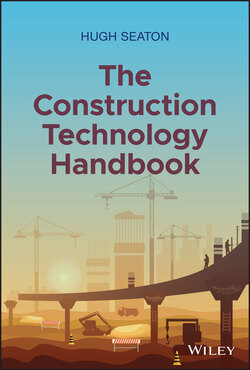Читать книгу The Construction Technology Handbook - Hugh Seaton - Страница 12
Technology Domains
ОглавлениеWhen we think of technology as a chain of these effects being used, we can more easily understand how to integrate new pieces. Technology is just a tool that is an extension of human power and action, no more, no less. By keeping in mind that any technology is there to extend your power and action, you can put it into a context that helps both assess how good that technology is, and understand why new technologies might be better than old ones – they are using a newer, better effect to help you. In fact, it is more often the case that the tools you use are exploiting a bundle of effects to work, and the part you will care most about, the effects being exploited that matter to you most are human and organizational effects.
And by understanding all technology as being part of a chain you are part of, you can be clearer with the creators of that technology about how they should develop and deliver real products. What is happening in construction now is that parts of the chain of technology, starting with your skills and extending to the tools you use, are being added and changed. Understanding modern technology not as a separate class of things, but just the latest in a series of “modules” that can be swapped into an existing chain is a much better perspective, because it keeps technology under the category of “tools” – not something alien.
Technologies themselves are always a collection of other technologies. Even something as simple as a hammer is the result of plastics, metallurgy, metal working, factory design, automation, ergonomics, and even packaging. Knowing that technologies are themselves composed of interlocking, lower level technologies, makes it easier to understand how our tools keep getting a little better, cheaper, and safer every year. For example, Milwaukee Tool has been making tools like torque wrenches for years, and over time they have swapped out some controls that were mechanical, like a direct lever between the trigger and the electrical motor, with electronics that give the user more operational fine tuning.
Milwaukee has recently added a new feature, their “One‐Key System,” that wirelessly keeps track of all the tools on a jobsite. You can look at this as just another feature, actually a pretty cool one, or you can look at it as Milwaukee swapping out the paper and pencil, or perhaps spreadsheet technology that relied on observation, memory, and making the rounds to keep up to date, with an automatic, real‐time inventory reporting tool. Your chain of technology has not changed, but the tool you use to do a part of it has.
Thinking of your job as a chain of tools, from your own skills to the external tools you use gives you, the professional using these technologies, the power to think creatively about what you're using, combine products and technologies in new ways, and demand that providers of technology products keep working until the products do what you need them to.
This idea of changing out one kind of technology for another is often referred to as changing the “domain” of technology being used. In the hammer example, we changed a manual force domain for a pneumatic force one. In the Milwaukee tools example, we changed from a manual inspection and reporting domain to a wireless, automatic updating domain.
This “redomaining” or swapping of one technology domain for another in human activity has been happening since the dawn of time. These new domains tend to come in waves, and as they do, there is an inevitable process of blending the seasoning and judgment of industry professionals with the new processes and skills that these new technologies bring with them. That's what we're in the middle of as an industry, replacing physical and industrial‐era techniques and technologies with digital domains.
From the examples above, human work was replaced by machines. Fears abound in the specialty trades, and contractors more generally, that technology is going to cause people to lose their jobs. We will address this very specifically in the AI and Industrialized Construction chapters, but for now, keep two points in mind: the first is that machines and software replace skills from the very bottom, starting with the most mindless tasks. Some of those tasks still require skill, like using a hammer well, but those skills are a small part of what makes a carpenter a professional. The second point is that what does make a carpenter, or pipefitter, or mechanical contractor a professional is the ability to solve problems, and to come up with solutions to complex obstacles that involve schedules, contractual terms, team dynamics, and many other things.
